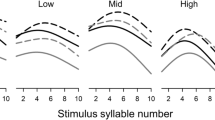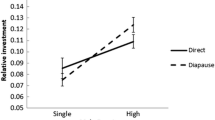Abstract
Selection is expected to maximize an individual’s own genetic reward regardless of the potential fitness consequences for its sexual partners, which may cause sexual conflict. Although performance in holometabolous insects typically diminishes with age, old male mating advantage has been documented in a few species. Whether this pattern arises from female preference for older males based on, e.g., pheromone blends (intersexual selection), or from increased eagerness to mate in older compared to younger males is currently debated. We explore the mechanistic basis of old male mating advantage, using a series of experiments including behavioral as well as manipulative approaches, in the tropical butterfly Bicyclus anynana. Consistent with the residual reproductive value hypothesis, old male mating advantage was associated with a greater eagerness to mate, evidenced by a two times higher flying and courting activity in older than in younger males. In contrast, we found only limited support for a contribution of female preference for older males based on pheromone composition, although male sex pheromones clearly do play a role in mating success. Our results suggest that male behavior may play a primary role in old male mating advantage, and that pheromones are likely of secondary importance only. Male mating success was related to higher overall pheromone titers rather than variation in a single component. A dominant importance of male behavior in determining mating success may result in sexual conflict.




Similar content being viewed by others
References
Arnqvist G, Rowe L (2005) Sexual conflict. Princeton University Press, New York
Bergmann M, Gotthard K, Wiklund C (2011) Mate acquisition by females in a butterfly: the effects of mating status and age on female mate-locating behaviour. Anim Behav 81:225–229
Brakefield PM (1997) Phenotypic plasticity and fluctuating asymmetry as responses to environmental stress in the butterfly Bicyclus anynana. In: Bijlsma RR, Loeschcke V (eds) Environmental stress: adaptation and Evolution. Birkhäuser, Basel, pp 65–78
Brakefield PM, Reitsma N (1991) Phenotypic plasticity, seasonal climate and the population biology of Bicyclus butterflies (Satyridae) in Malawi. Ecol Entomol 16:291–303
Brooks R, Kemp DJ (2001) Can old males deliver the good genes? Trends Ecol Evol 16:308–313
Cameron PJ, Wallace AR, Madhusudhan VV, Wigley PJ, Qureshi MS, Walker GP (2005) Mating frequency in dispersing potato tuber moth, Phthorimaea operculella, and its influence on the design of refugia to manage resistance in Bt transgenic crops. Entomol Exp Appl 115:323–332
Chambers GM, Klowden MJ (2001) Age of Anopheles gambiae Giles male mosquitoes at time of mating influences female oviposition. J Vector Ecol 26:196–201
Chapman T (2001) Seminal fluid-mediated fitness traits in Drosophila. Heredity 87:511–521
Chapman T, Liddle LF, Kalb JM, Wolfner MF, Partridge P (1995) Cost of mating in Drosophila melanogaster is mediated by male accessory gland products. Nature 373:241–244
Chapman T, Takahisa M, Smith HK, Partridge P (1998) Interactions of mating, egg production and death rates in females of the Mediterranean fruit fly, Ceratitis capitata. Proc R Soc Lond B 265:1879–1894
Conner J (1989) Older males have higher insemination success in a beetle. Anim Behav 39:503–509
Costanzo K, Monteiro A (2007) The use of chemical and visual clues in female choice in the butterfly Bicyclus anynana. Proc R Soc Lond B 274:845–851
Enquist M, Leimar O (1990) The evolution of fatal fighting. Anim Behav 39:1–9
Ferkau C, Fischer K (2006) Costs of reproduction in male Bicyclus anynana and Pieris napi butterflies: effects of mating history and food limitation. Ethology 112:1117–1127
Fischer K (2006) Reduced male mating vigor in selection lines of the butterfly Bicyclus anynana. J Insect Behav 19:657–668
Fischer K (2007) Control of female reproduction and a survival cost to mating in a butterfly. Ecol Entomol 32:674–681
Fischer K, Bot ANM, Brakefield PM, Zwaan BJ (2003) Fitness consequences of temperature-mediated egg size plasticity in a butterfly. Funct Ecol 17:803–810
Fischer K, Perlick J, Galetz T (2008) Residual reproductive value and male mating success: older males do better. Proc R Soc Lond B 275:1517–1524
Fricke C, Maklakow AA (2007) Male age does not affect female fitness in a polyandrous beetle Callosobruchus maculatus. Anim Behav 74:541–555
Geister TL, Fischer K (2007) Testing the beneficial acclimation hypothesis: cool males – hot love? Behav Ecol 18:658–664
Geister TL, Lorenz MW, Meyering-Vos M, Hoffmann KH, Fischer K (2008) Effects of temperature on reproductive output, egg provisioning, juvenile hormone and vitellogenin titres in the butterfly Bicyclus anynana. J Insect Physiol 54:1253–1260
Harari AR, Zahavi T, Thiéry T (2011) Fitness cost of pheromone production in signaling female moth. Evolution 65:1572–1582
Janowitz SA, Fischer K (2010) Costing reproduction: effects of mating opportunity on mating success in male Bicyclus anynana butterflies. Behav Ecol Sociobiol 64:1999–2006
Janowitz SA, Fischer K (2012) Polyandry in Bicyclus anynana butterflies results from sexual conflict over mating. Ethology 118:1140–1148
Johnstone RA, Rands SA, Evans MR (2009) Sexual selection and condition-dependence. J Evol Biol 22:2387–2394
Judge KA (2011) Do male field crickets, Gryllus bimaculatus, signal their age? Anim Behav 81:185–194
Karl I, Fischer K (2009) Altitudinal and environmental variation in lifespan in the Copper butterfly Lycaena tityrus. Funct Ecol 23:1132–1138
Karl I, Fischer K (2013) Old male mating advantage results from sexual conflict in a butterfly. Anim Behav 85:143–149
Karlsson B (1994) Feeding habits and change of body compositions with age in three nymphalid butterflies species. Oikos 69:224–230
Kemp DJ (2002) Butterfly contests and flight physiology: why do older males fight harder? Behav Ecol 213:456–461
Kemp DJ (2006) Ageing, reproductive value, and the evolution of lifetime fighting behaviour. Biol J Linn Soc 88:565–578
Kemp DJ, Rutowski RL (2004) A survival cost to mating in a polyandrous butterfly, Colias eurytheme. Oikos 105:65–70
Kemp DJ, Wiklund C (2001) Fighting without weaponry: a review of male-male contest competition in butterflies. Behav Ecol Sociobiol 49:429–442
Kuijper B, Stewart AD, Rice WR (2006) The cost of mating rises nonlinearly with copulation frequency in a laboratory population of Drosophila melanogaster. J Evol Biol 19:1795–1802
Lappin AK, Brandt Y, Husak JF, Makedonia JM, Kemp DJ (2006) Gaping displays reveal and amplify a mechanistically based index of weapon performance. Am Nat 168:100–113
Larsen TB (1991) The butterflies of Kenya and their natural history. Oxford University Press, Oxford
Marden JH, Waage JK (1990) Escalated damselfly territorial contests are energetic wars of attrition. Anim Behav 39:954–959
Mays HL, Hill GE (2004) Choosing mates: good genes versus genes that are a good fit. Trends Ecol Evol 19:554–559
Milonas PG, Andow DA (2010) Virgin male age and mating success in Ostrinia nubilalis (Lepidoptera: Crambidae). Anim Behav 79:509–514
Nieberding CM, de Vos H, Schneider MV, Lassance J-M, Estramil N, Andersson J, Bång J, Hedenström E, Löfstedt C, Brakefield PM (2008) Male sex pheromones in the butterfly Bicyclus anynana: towards an evolutionary analysis. PLoS One 3:e2751
Nieberding C, Fischer K, Saastamoinen M, Allen CE, Wallin EA, Hedenström E, Brakefield PM (2012) Cracking the olfactory code of a butterfly: the scent of ageing. Ecol Lett 5:415–424
Parker GA (1974) Assessment strategy and the evolution of fighting behaviour. J Theor Biol 47:223–243
Paukku S, Kotiaho JS (2005) Cost of reproduction in Callosobruchus maculatus: effects of mating on male longevity and the effect of male mating status on female longevity. J Insect Physiol 51:1220–1226
Perez-Staplez D, Martínez-Hernández MG, Aluja M (2010) Male age and experience increases mating success but not female fitness in the Mexican fruit fly. Ethology 116:778–786
Rivero A, Alatalo RV, Kotiaho JS, Mappes J, Parri S (2000) Acoustic signalling in a wolf spider: can signal characteristics predict male quality? Anim Behav 60:187–194
Robertson KA, Monteiro A (2005) Female Bicyclus anynana butterflies choose males on the basis of their dorsal UV-reflective eyespot pupils. Proc R Soc Lond B 272:1541–1546
Ryan MJ (1988) Energy, calling and selection. Am Zool 28:885–898
Schneider JM, Lesmono K (2009) Courtship raises male fertilization through post mating sexual selection in a spider. Proc R Soc Lond B 276:3105–3111
Simmons LW, Zuk M (1991) Variability in call structure and pairing success of male field crickets, Gryllus bimaculatus: the effects of age, size, and parasite load. Anim Behav 44:1145–1152
Srivastava S, Omkar (2004) Age-specific mating and reproductive senescence in the seven-spotted ladybird, Coccinella septempunctata. J Appl Entomol 128:452–458
Trivers RL (1972) Parental investment and sexual selection. In: Campell B (ed) Sexual selection and the descent of man. Chicago Press, Chicago, pp 136–179
Vahed K (1998) The function of nuptial feeding in insects — review of empirical studies. Biol Rev 73:43–78
Velando A, Beamonte-Barrientos R, Torres R (2006) Pigment-based skin colour in the blue-footed booby: an honest signal of current condition used by females to adjust reproductive investment. Oecologia 149:535–542
Walther BH, Clayton DH (2005) Elaborate ornaments are costly to maintain: evidence for high maintenance handicaps. Behav Ecol 16:89–95
Wedell N, Karlsson B (2003) Paternal investment directly affects female reproductive effort in an insect. Proc R Soc Lond B 270:2065–2071
Wyatt TD (2003) Pheromones and animal behavior. Communication by smell and taste. Cambridge University Press, Cambridge
Zuk M (1988) Parasite load, body size, and age of wild-caught male field crickets (Orthoptera: Gryllidae): effects on sexual selection. Evolution 42:969–976
Acknowledgments
We are indebted to Caroline Nieberding for providing synthetic MSPs for experiment 2, stimulating discussions regarding the design of our experiments, and for providing constructive criticism on earlier versions of this manuscript. Financial support was provided by the German Research Foundation (DFG grant Fi 846/5-1 to KF) and by "Fonds National de la Recherche Scientifique" (grants FRFC 2.4560.11 and 2.4600.10). This is publication BRC 265 from the BDIV Research Centre.
Conflict of interest
The authors declare that they have no conflict of interest.
Author information
Authors and Affiliations
Corresponding author
Additional information
Communicated by D. Kemp
Rights and permissions
About this article
Cite this article
Karl, I., Heuskin, S. & Fischer, K. Dissecting the mechanisms underlying old male mating advantage in a butterfly. Behav Ecol Sociobiol 67, 837–849 (2013). https://doi.org/10.1007/s00265-013-1507-8
Received:
Revised:
Accepted:
Published:
Issue Date:
DOI: https://doi.org/10.1007/s00265-013-1507-8




